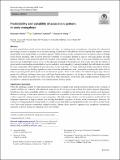Files in this item
Predictability and variability of association patterns in sooty mangabeys
Item metadata
| dc.contributor.author | Mielke, Alexander | |
| dc.contributor.author | Crockford, Catherine | |
| dc.contributor.author | Wittig, Roman M | |
| dc.date.accessioned | 2021-11-30T11:30:18Z | |
| dc.date.available | 2021-11-30T11:30:18Z | |
| dc.date.issued | 2020-03-23 | |
| dc.identifier | 276614348 | |
| dc.identifier | 9c24daf6-c612-4b0d-8793-88dbc12a0360 | |
| dc.identifier | 85082529305 | |
| dc.identifier.citation | Mielke , A , Crockford , C & Wittig , R M 2020 , ' Predictability and variability of association patterns in sooty mangabeys ' , Behavioral Ecology and Sociobiology , vol. 74 , no. 4 , 46 . https://doi.org/10.1007/s00265-020-2829-y | en |
| dc.identifier.issn | 0340-5443 | |
| dc.identifier.other | Bibtex: mielke2020predictability | |
| dc.identifier.uri | https://hdl.handle.net/10023/24439 | |
| dc.description | Open access funding provided by Projekt DEAL. AM, CC, and RMW were supported by the Max Planck Society; AM was supported by the Wenner Gren Foundation (Grant Number 9095); CC was supported by the European Research Council (ERC) under the European Union’s Horizon 2020 research and innovation programme (grant agreement no. 679787). Research at the Taï Chimpanzee Project has been funded by the Max Planck Society since 1997. | en |
| dc.description.abstract | In many group-living animal species, interactions take place in changing social environments, increasing the information processing necessary to optimize social decision-making. Communities with different levels of spatial and temporal cohesion should differ in the predictability of association patterns. While the focus in this context has been on primate species with high fission-fusion dynamics, little is known about the variability of association patterns in species with large groups and high temporal cohesion, where group size and the environment create unstable subgroups. Here, we use sooty mangabeys as a model species to test predictability on two levels: on the subgroup level and on the dyadic level. Our results show that the entirety of group members surrounding an individual is close to random in sooty mangabeys; making it unlikely that individuals can predict the exact composition of bystanders for any interaction. At the same time, we found predictable dyadic associations based on assortative mixing by age, kinship, reproductive state in females, and dominance rank; potentially providing individuals with the ability to partially predict which dyads can be usually found together. These results indicate that animals living in large cohesive groups face different challenges from those with high fission-fusion dynamics, by having to adapt to fast-changing social contexts, while unable to predict who will be close-by in future interactions. At the same time, entropy measures on their own are unable to capture the predictability of association patterns in these groups. | |
| dc.format.extent | 13 | |
| dc.format.extent | 584974 | |
| dc.language.iso | eng | |
| dc.relation.ispartof | Behavioral Ecology and Sociobiology | en |
| dc.subject | Social system | en |
| dc.subject | Fission fusion | en |
| dc.subject | Sooty Mangabey | en |
| dc.subject | Entropy | en |
| dc.subject | Association | en |
| dc.subject | Social complexity | en |
| dc.subject | BF Psychology | en |
| dc.subject | DAS | en |
| dc.subject.lcc | BF | en |
| dc.title | Predictability and variability of association patterns in sooty mangabeys | en |
| dc.type | Journal article | en |
| dc.contributor.institution | University of St Andrews. School of Psychology and Neuroscience | en |
| dc.identifier.doi | https://doi.org/10.1007/s00265-020-2829-y | |
| dc.description.status | Peer reviewed | en |
This item appears in the following Collection(s)
Items in the St Andrews Research Repository are protected by copyright, with all rights reserved, unless otherwise indicated.

